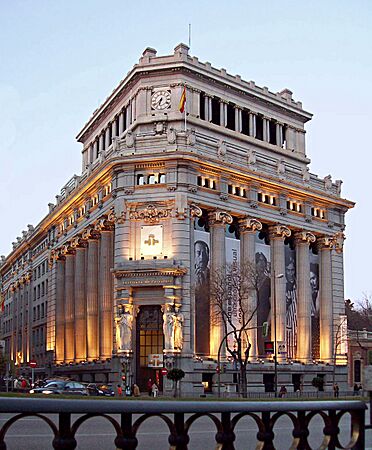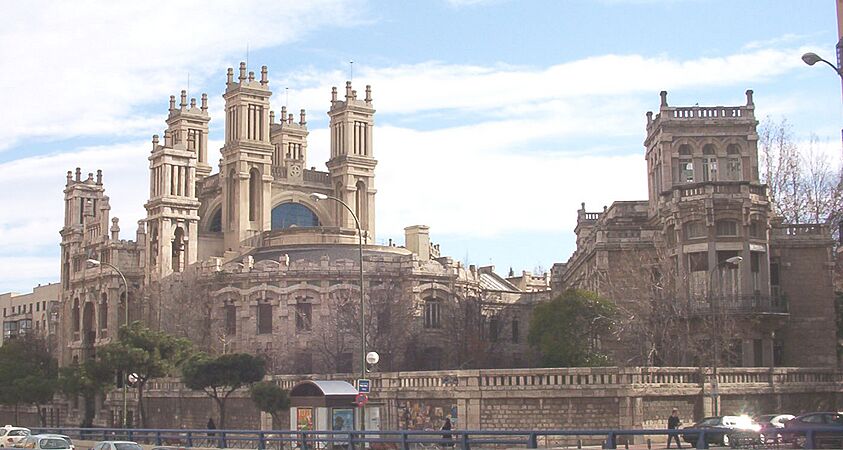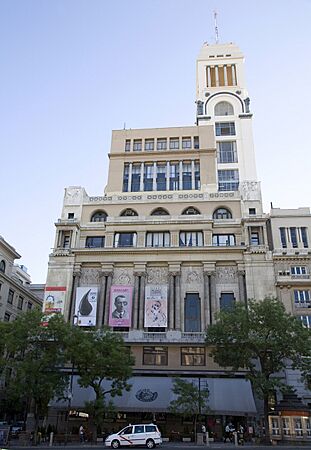Antonio Palacios facts for kids
Quick facts for kids
Antonio Palacios Ramilo
|
|
|---|---|
 |
|
| Born | 8 January 1874 O Porriño, Spain
|
| Died | 27 October 1945 (aged 73) El Plantío, Spain
|
| Nationality | Spanish |
Antonio Palacios Ramilo (born January 8, 1874 – died October 27, 1945) was a famous Spanish architect. He designed many big, impressive buildings, especially in Madrid. His style, called eclecticism, mixed different old and new ideas. He helped shape how Madrid looked in the early 1900s.
Contents
Antonio Palacios: A Spanish Architect
Early Life and Education
Antonio Palacios was born on January 8, 1874. His hometown was O Porriño in the province of Pontevedra, Spain. When he was older, Palacios moved to Madrid. He first started studying to become an engineer. However, he soon changed his mind. He decided to study architecture instead. He finished his architecture degree in 1903.
Designing Modern Madrid
Palacios was a very busy architect. He designed many buildings that changed the look of Madrid. These buildings are some of the most famous in the city. He was inspired by different styles. One style was modernismo, which was popular at the time. But he also mixed in other styles. These included Neoplateresque and Neoclassicism. He even used ideas from modern American buildings. This mix of styles is what made his work unique.
Antonio Palacios also designed parts of the Metro de Madrid. This is Madrid's subway system. He created the famous diamond-shaped logo for the subway. This logo is still used today. In 1926, he became a member of the Real Academia de Bellas Artes de San Fernando. This is a very important art academy in Spain. Antonio Palacios passed away on October 27, 1945. He died in El Plantío, a place near Madrid.
Famous Buildings by Palacios
Antonio Palacios designed many important buildings. Here are some of his most well-known works.
Buildings in Madrid
- Palacio de Comunicaciones (1904): This grand building was once the main post office. Today, it is Madrid's City Hall.
- Banco del Río de la Plata (1910): A beautiful bank building.
- Hospital de Maudes (1908): Originally a hospital, known for its unique design.
- Talleres del ICAI (1908)
- Banco del Comercio y de la Industria (1914)
- Templete del Metro de la Gran Vía (1919): This was an entrance to the subway. It was later moved to his hometown, O Porriño.
- Edificios comerciales de la calle Mayor 4, Gran Vía 27 & 34 (1919 and 1921): Commercial buildings he designed.
- Círculo de Bellas Artes (1919): A famous cultural center.
- Hotel Florida (1922): This hotel was later taken down in 1964.
- Casa de Antonio Palacios, in El Plantío, Madrid (1942): His own home.
- Banco Mercantil e Industrial (1945)
Buildings in Galicia
- Teatro Rosalía de Castro, in Vigo (1906): A theater in the city of Vigo.
- Virxe da Roca, in Baiona, Pontevedra (1912): A large stone monument.
- Casa do concello do Porriño, in O Porriño (1919): The town hall in his hometown.
- Banco de Vigo, in Vigo (1941)
- Templo votivo do Mar, in Panxón, Nigrán (1932): A special church by the sea.
- Mosteiro da Visitación, in Vigo (1942)
- Igrexa da Vera Cruz, in O Carballiño (1943)
See also
 In Spanish: Antonio Palacios para niños
In Spanish: Antonio Palacios para niños





